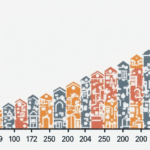Regional Growth Outlook for 2025 and Beyond
According to the latest projections by the World Bank, released on Tuesday, Latin America and the Caribbean are expected to grow by 2.3% this year, a slight increase from the previous forecast for 2024. However, it remains the lowest regional growth rate in the world.
In 2024, the region grew by 2.2%. In its previous projection for 2025, released in April, the World Bank anticipated a growth rate of 2.1%, which is two decimal points less than the new projection.
Growth Projections for 2026
Looking ahead to 2026, the updated calculations from the institution predict a growth rate of 2.5%.
“It is expected that the regional growth rate will increase slightly this year,” explains the World Bank, although it warns that “several individual economies are facing downward revisions in their projections.”
Individual Country Projections
Argentina stands out with a growth projection of 4.6%, compared to -1.3% in 2024.
Among the two largest economies in the region, Brazil’s growth rate is expected to decrease from 3.4% in 2024 to 2.4%. Meanwhile, Mexico’s growth rate is only projected to be +0.5%.
The World Bank projects that Mexico’s economy will grow by 0.5% this year, up from the 0.2% projected in June, with growth expected to accelerate to 1.4% next year.
“This reflects, in part, a limited external support environment characterized by a slowing global economy, falling commodity prices, and increased uncertainty,” states the World Bank.
Monetary Management and Challenges
The World Bank acknowledges that regional central banks are “effectively managing inflation,” but notes that the “final mile” is proving to be more challenging than anticipated.
Susana Cordeiro Guerra, the newly appointed World Bank Vice President for the region, emphasizes that while governments in the region have “guided their economies through repeated crises while preserving stability,” they now need to “accelerate reforms.”
The external environment remains complex, with a decline in global demand and commodity prices projected to fall by around 10% in 2025 and another 5% in 2026, negatively impacting key sectors.
Parallel to Africa
The World Bank advocates for stimulating the growth of “transformative businesses” that are more ambitious than family-owned microenterprises, which can sometimes account for up to 70% of a nation’s economy.
William Maloney, the World Bank’s Chief Economist for Latin America and the Caribbean, explains that these businesses prefer “flexibility and independence,” although none plan to expand. These types of enterprises are not the ones that will create jobs or bring new technologies to the region.
In Latin America, “30% of companies say they want to grow but cannot due to a lack of skilled labor,” according to Maloney.
Impact of Artificial Intelligence
The impact of artificial intelligence (AI) on this landscape is not yet concerning for the region, according to Maloney.
- Mid-term job displacement: “The answer is that, likely, not many jobs will be lost in the medium term.”
- Participation in technological advancements: “The real question is whether we will be participants in all of this.”
Maloney notes that universities in the region are “not particularly productive in terms of new inventions” and are not “closely integrated with the private sector.”
“We are tied with Africa in terms of cooperation with private sectors, and this simply cannot continue,” Maloney expressed.






